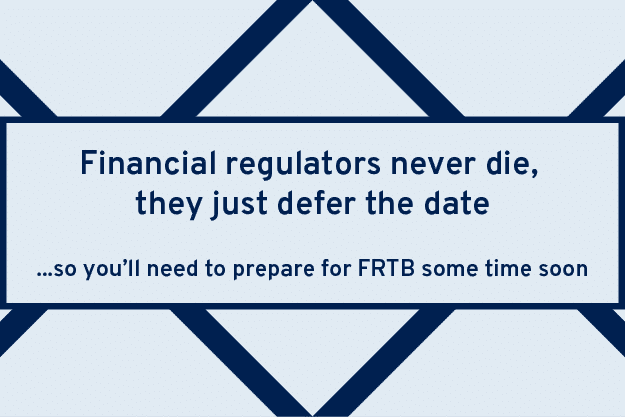No bank wants to kick off a new year feeling completely overwhelmed, which is why when it comes to FRTB, decisions need to be made sooner rather than later on which strategy to adopt. Firms need to decide whether to use a standardized Sensitivities Based Method or an Internal Model Approach. Historically, all firms with trading operations have been required to use internal models, due to the fact that the standard approach relied on notional instead of risk sensitivities. The problem lies in the fact that, under FRTB, a large proportion of current internal models won’t be up to scratch when it comes to ensuring the right level of capital is readily available to cope with a time of stress. And with the geopolitical climate the way it is, trading desks may be in for more than a few bouts of stress throughout 2018 and beyond.
Banks have been given up to 3 years extra time to iron out all the operational wrinkles (of which there are many) involved in implementing the market risk and regulatory capital rules commonly known as the Fundamental Review of the Trading Book (FRTB). At a meeting in December 2017 the Basel Committee’s Governors and Heads of Supervision announced a revised implementation date of Jan 1st 2022 for the revised minimum capital requirements for market risk, the official name for FRTB. Let’s explore the two approaches banks could take to address this regulation.
Sensitivities Based Method
The Sensitivities Based Method (SBM), also known as the Sensitivities Based Approach (SBA), provides a standardized method of calculating market risk capital. Banks will calculate their capabilities to deal with stress according to the examination of each risk class under three different scenarios, the results of which are then used to analyse the subsequent impact of the scenarios on their portfolios. In order to reduce this reliance on internal models, the Sensitivities Based Method provides a credible alternative for trading desks to operate under a capital regime that is conservative, but not totally punitive. There are still teething issues due to some ambiguities on the exact methodologies of these approaches but these will be ironed out as regulators begin to feedback to the industry in more depth.
Internal Model Approach
Those taking the Internal Model Approach (IMA) route need to satisfy an overall assessment where they pitch their risk measurement model to their regulatory supervisor. As part of this they have to nominate and then gain approval for individual trading desks, as outlined by the European Banking Authority (EBA) recently. This presents a significant challenge as it places additional responsibility with each desk head for the capital output, and increases the complexity for bulge bracket institutions running hundreds of trading desks. Each desk will need to put in place a management structure which controls the information driving its internal model, not to mention understand how the output can be used for risk management. It’s worth noting that, in all likelihood, as it stands, the option to go for an IMA will only apply to large banks as they have greater capacity to take on this approach. These banks have to consider how best to prepare the infrastructure – particularly considering they will have to examine each trading desk and will have to revert them to a the standardized approach should they fail risk factor eligibility tests (RFET) or hypothetical model-generated P&L tests, which are a contentious issue in and of themselves.
Accurate and Accessible Data
Regardless of the model banks adopt, underpinning FRTB brings specific data challenges. It’s crucial that firms have accurate and accessible market and risk data-sets to ensure their models and calculations stand the best possible chance of avoiding any unwanted additional scrutiny. Banks are bound to encounter issues around the volume and granularity of the underlying data sets required to run risk and capital calculations, including the modellability of risk factors for IMA, and the sooner this issue is addressed, the less risk and last minute panic there is down the line, as there was with MiFID II preparations. This is why, regardless of the selected approach, a fresh start and renewed approach to data relating to the incoming regulation is needed at the outset of every bank’s FRTB preparations.
While the January 1st 2022 deadline may seem like a way off, and while there is always the chance that further delays might occur, as they often do with regulatory timetables, one look at the scale of the work ahead shortens the timeframe somewhat. Banks will have to fundamentally reorganize their trading operations as well as upgrade their technological capabilities and improve any outdated procedures – there’s certainly a lot to get done. And this is in addition to two additional Basel III regulatory revisions for credit risk and operational risk, announced in the same BIS press release and having the same 2022 start date as FRTB. The banks that have identified how to get the most out of their internal and external data sets will be best positioned to get their FRTB preparations off to the best possible start.
Click here to read more about FRTB, or click here to learn about the GoldenSource FRTB solution

